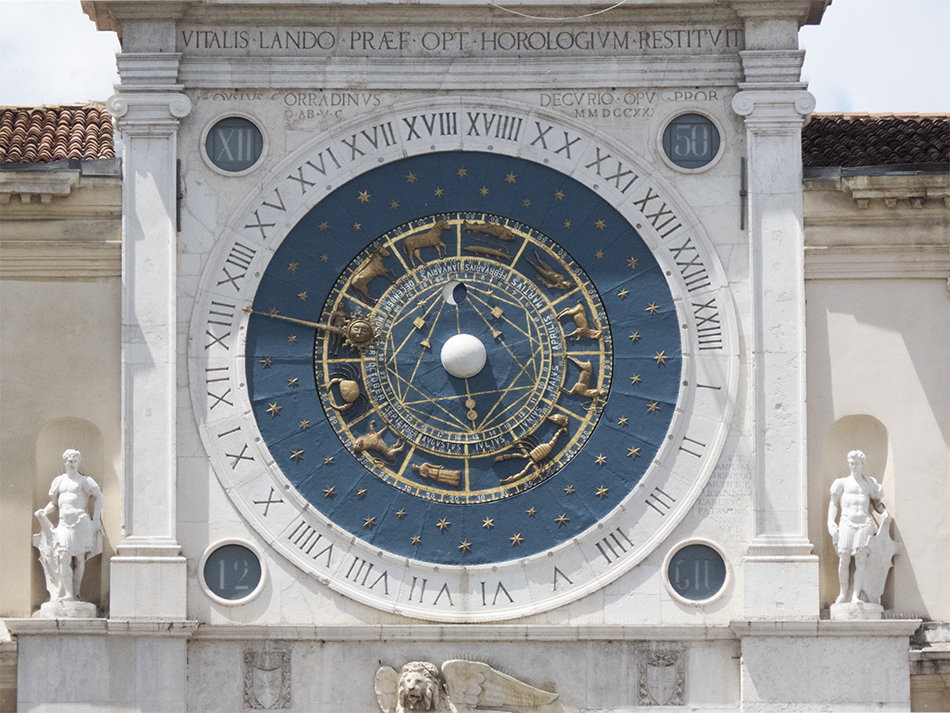
Although time and its measurement is a fundamental component of human life, a special type of clock which takes matters to the next level is the so-called
astronomical clock and whose purpose is not to measure time per se but to convey astronomical information and, in particular, the relative position of the
Sun and Moon as well as the zodiacal constellations and, in some cases, the position of the planets all as a function of time.
The oldest such effort to effectively emulate the overhead celestial sphere (ie a mini-planetarium) is the
Antikythera Mechanism which was discovered in 1901 totally by
accident by sponge divers off the coast of the Greek island of Antikythera. It has been dated to approximately 80 BC and it is believed to be the work of
Poseidonius of Rhodes. The Antikythera Mechanism is currently on display
at the National Archaeological Museum in Athens, Greece.
Note: Although the city of Padova is perhaps best known for being home to Galileo between 1592 and 1610 and where he assumed a
professor's position in mathematics, it is also host to perhaps the world's oldest (astronomical) clock, for it was originally built in 1344 AD following
the design by Jacopo Dondi. Unfortunately, violent clashes between forces from Milan and Venice in their efforts to gain control of Padova saw the destruction
of the clock in 1390 and a faithful copy of the clock was eventually commissioned in its place in 1427. Careful inspection of the photo below will reveal one
interesting omission, namely the absence of Libra along the ring of zodiacal constellations. According to one version of the story, the craftsman employed to
rebuld the faithful copy was not paid the original funds promised to him and he purposely duplicated the constellation of Scorpio in revenge, thus leading to
the omission of Libra.
The design of the clock is very much similar to other clocks which would follow in later centuries. For example, the outer ring is comprised of the roman
numerals I through XXIV and which represent the hour of each day. The following ring is strictly for cosmetic purposes and displays the stars against a blue
sky and is followed by another ring with the zodiacal constellations including the anomaly alluded to above. The next ring, somewhat thinner than the rest,
has the months written in Latin starting with Febryarivs (at the 12 o'clock position) and proceeding clockwise with Martivs, Aprilis etc. A white cone
at the absolute center of the clock represents Earth and is a reflection of the Aristotelian/Ptolemaic view of the Solar System and which prevailed at the
time. Finally, the Moon and its phases are represented by a disk which is partially shaded accordingly whereas the Sun is present on the hand dial which
points to the corresponding time of the day while also straddling the ring with the zodiacal constellations, thus revealing the current constelllation it
is passing through.
The tower which hosts the clock of Padova is comprised of five floors and measures thirty meters tall. The initial three floors host the clock's extensive
mechanism whereas the other two floors were for housing the timekeeper (horologist) responsible for maintaining the clock itself. Today, the tower's internals
are open to the public and 30-minute tours (at 10:00, 10:30, 11:00 and 11:30) are available for free every Wednesday, Friday and Saturday morning for groups
up to 10 people.
Note: For a view of the astronomical clock using different focal length, please click
here and
here.
Note: For additional results involving astronomical clocks from around the world, please click
here.
|
Body: Sun Mass: 332,900 x Earth Mass Eq Diameter: 109.1 x Earth Distance: 149 million km RA / Dec: 23h 41m 41s / +89° 19' 51" Diameter: 32.16' Magnitude: -26.8 |
 |
Date: June 12, 2023 Location: Piazza Dei Signori, Padova, Italy Equipment: Canon PowerShot SX60 HS @ 40.32 mm / f7.1 Exposure: 1 x 1/1000 sec ISO 400 RAW Image Format 4768x3516 Image Size Continuous Servo Mode Manual Mode Software: Photoshop CS6 Processing: Brightness/Contrast Resampling JPG Compression |